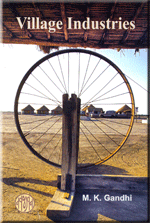
P.O. SEVAGRAM, DIST.WARDHA 442102, MS, INDIA. Phone: 91-7152-284753
FOUNDED BY MAHATMA GANDHI IN 1936
Village Industries

VILLAGE INDUSTRIES
Written by :M. K. Gandhi
Table of Contents
- Why The Village Industries Movement
- Causes of Decline of Village Industries
- Dangers of Mechanization
- Rehabilitation of Village Industries
- Difficulties in The Way
- Pattern of State Assistance
- Spinning Wheel : The Life-Giving Sun
- Tanning
- Dairying
- Gur and Khandsari
- Other Village Industries
- Village Exhibitions
About This Book
Written by : M. K. Gandhi
Edited by : Bharatan Kumarappa
First Edition : 10,000 copies, April 1960
I.S.B.N : 81-7229-121-3
Printed and Published by : Jitendra T. Desai
Navajivan Mudranalaya,
Ahmedabad - 380 014,
India.
© Navajivan Trust, 1960
Download
Chapter-7: Spinning Wheel : The Life-Giving Sun
I feel convinced that the revival of hand-spinning and hand-weaving will make the largest contribution to the economic and the moral regeneration of India. The millions must have a simple industry to supplement agriculture. Spinning was the cottage industry years ago, and if the millions are to be saved from starvation, they must be enabled to reintroduce spinning in their homes, and every village must repossess its own weaver.
Young India, 21-7-1920
I... claim for the Charkha the honour of being able to solve the problem of economic distress in a most natural, simple, unexpensive and businesslike manner. The Charkha, therefore, is not only not useless... but it is a useful and indispensable article for every home. It is the symbol of the nation's prosperity and, therefore, freedom. It is a symbol not of commercial war but of commercial peace. It bears not a message of ill-will towards the nations of the earth but of good-will and self-help. It will not need the protection of a navy threatening a world's peace and exploiting its resources, but it needs the religious determination of millions to spin their yarn in their own homes as today they cook their food in their own homes. I may deserve the curses of posterity for many mistakes of omission and commission, but I am confident of earning its blessings for suggesting a revival of the Charkha. I take my all on it. For every revolution of the wheel spins peace, good-will and love. And with all that, inasmuch as the loss of it brought about India's slavery, its voluntary revival with all its implications must mean India's freedom.
Young India, 8-12-1921
What is claimed for spinning is that:
- it supplies the readiest occupation to those who have leisure and are in want of a few coppers;
- it is known to the thousands;
- it is easily learnt;
- it requires practically no outlay of capital;
- the wheel can be easily and cheaply made. Most of us do not yet know that spinning can be done even with a piece of tile and splinter;
- the people have no repugnance to it;
- it affords immediate relief in times of famine and scarcity;
- it alone can stop the drain of wealth which goes outside India in the purchase of foreign cloth;
- it automatically distributes the millions thus saved among the deserving poor;
- even the smallest success means so much immediate gain to the people;
- it is the most potent instrument of securing co-operation among the people.
Young India, 21-8-1924
I have often said that if seven lakhs of the villages of India were to be kept alive, and if peace that is at the root of all civilization is to be achieved, we have to make the spinning wheel the centre of all handicrafts. Thus my faith in the spinning wheel is growing every day and I see it more and more clearly that the Sun of the wheel will alone illumine the planets of other handicrafts. But I go a step further and say that just as we go on discovering new stars and planets in the vast solar system, even so we shall go on discovering fresh handicrafts every day. But for the sake of this thing, we have to make the spinning wheel the really life-giving Sun.
Harijan, 19-2-1938